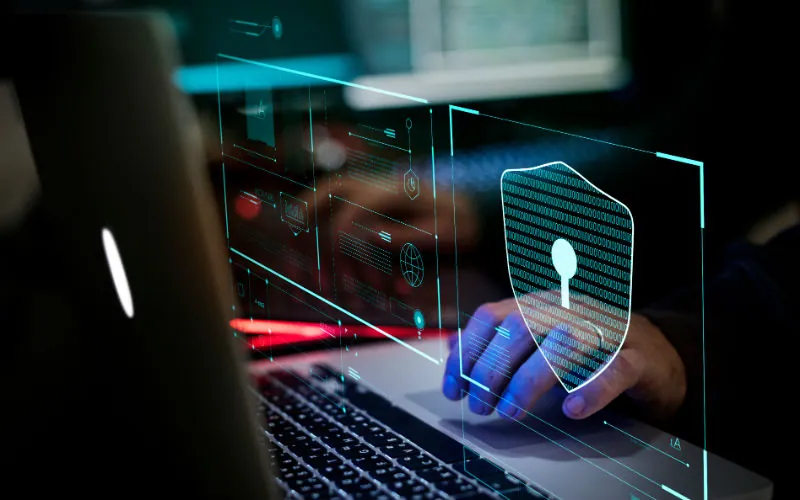Artificial Intelligence has become a transformative force in many sectors. Recently, digital threats have grown significantly in difficulty and frequency forcing humans to turn to the double-edged sword, AI, a powerful tool for defense but also a potential weapon for attackers. To build a safe and resilient system, one must first understand the benefits and drawbacks of AI.
AI refers to systems or machines that mimic human intelligence to perform tasks and improve themselves based on the information they collect. In cybersecurity, AI is employed to detect threats, automate responses, analyze behavior, and more. It uses features like language processing and data analytics to recognize and potentially eliminate threats. AI has the ability to quickly process massive data information with little human intervention. However, its adoption also introduces a set of ethical, technical, and security concerns.
Artificial Intelligence found its place in many industries, retail, crypto casinos, e-commerce and more, and is actively implemented in order to enhance personalization and improve security and privacy.
Benefits of AI in Cybersecurity
Enhanced Threat Detection and Response
One of the primary benefits of introducing AI in cybersecurity is its capacity to detect threats faster and more accurately than traditional systems. Algorithms can quickly spot patterns that are made to compromise sensitive data, or are associated with malware, and phishing attempts.
Over time, AI concentrates on a certain behavior of the users or consumers and uses them to pick up on unusual deviations flagging them as threats. For example, if an online casino player has available funds of $1000 and every day keeps playing megaways slots that require a bet of $1. Then, one day, he puts all his money on one hand of poker, this could trigger AI to flag it down as potential fraud.
This system is also often used by financial systems to discover threats with unusual credit card charges or requests.
Before the utilization of AI, systems reacted once the threat was executed, whereas today, AI systems can identify and neutralize threats that have not yet been documented. This massively improved the way we deal with potential frauds, by preventing them before they even happen.
Automation of Security Tasks
Most of the tasks in cybersecurity that are performed by humans are repetitive and tedious in nature. Log analysis, threat detection, classifying incidents and managing patching were all done by people sitting at their desks typing away for days. The introduction of AI frees up human analysts to focus on making strategic decisions and solving complex threats. It also helps organizations respond to incidents more quickly, reducing the length of time spent roaming around data systems.
Predictive Capabilities
In a matter of seconds, AI can analyze an enormous amount of data from the past and use the information to predict potential vulnerabilities. It can also suggest steps to mitigate the damage or eliminate the threat altogether. After the problem is resolved, AI is also capable of making conclusions based on past experiences and suggesting a proactive approach by implementing preventive measures. For example, AI tools may analyze data from past breaches to predict which systems might be targeted next and adjust firewalls or security protocols accordingly.
Scalability
Another great benefit is that AI-driven cybersecurity solutions can scale more efficiently than humans. Regardless of how big data systems become in the future, AI is ready to take on the task of analyzing and preventing cyberattacks without the need for more staff. Cloud environments, in particular, benefit from this scalability, as AI can monitor thousands of virtual machines and services simultaneously.
Real-Time Monitoring
AI enables continuous, real-time surveillance of networks and endpoints. Traditional security tools are slow to react and often miss more subtle threats, while AI can quickly recognize irregularities and react before the damage is done. These kinds of fast responses have proved to be especially useful in financial systems and government agencies where an immense amount of sensitive personal data is stored. Acting like a constant security guard and a watchful eye, AI has significantly improved the way we react to potential frauds and data breaches.
Phishing and Social Engineering Prevention
AI can detect phishing attempts through the analysis of email content, URLs, and sender behavior. NLP, Natural Language Processing, is used to spot unusual text that is often used by malicious intruders. Further, AI can go beyond just identifying the threat but can also alert users about possible cyberattacks before they click a suspicious link or download a harmful file.
This ability became especially useful since cybercriminals started using emails to defraud consumers with their authentic emails, logos and even the names of the officials. Many people fell for the fraudulent letters from fake government agencies, or financial institutions, sending their personal information to tricksters. AI successfully eliminated these malicious intents and prevented numerous attacks on sensitive data.
Cybersecurity Workforce Augmentation
The global cybersecurity workforce shortage is a persistent challenge since humans don’t find it to be a lucrative profession. Protecting digital assets has increased the ranks of the world’s cybersecurity workforce to 7.1 million, but another 2.8 million jobs remain unfilled.
The gap between supply and demand is biggest in the Asia-Pacific region, where the field is still relatively immature. Four industries account for close to two-thirds (64%) of the cybersecurity workforce shortage: financial services, materials and industrials, consumer goods, and technology.
AI helps bridge the gap by augmenting human capabilities and offering intelligent insights to limited or less experienced employees. Tools like SIEM, Security Information and Event Management, platforms provide recommendations to cybersecurity teams in order to promptly react to any potential anomalies. This also helps with the shortages of humans, since the ones that are making a career in data security can make quicker and more concise decisions.
Risks of AI in Cybersecurity
Even though, according to many IT experts, AI has way more benefits than flaws, there are still some concerns that need addressing. In some cases, AI with its features can pose a significant risk to systems while, at the same time, trying to protect them.
Weaponization of AI by Hackers
One of the most alarming risks is that cybercriminals are also using AI to conduct more sophisticated attacks. There are several ways cybercriminals use AI to their advantage.
Polymorphic malware was developed to repeatedly mutate its appearance or signature files through new decryption routines. This makes many traditional cybersecurity tools, such as antivirus or antimalware solutions, which rely on signature based detection, fail to recognize and block the threat. Simply put, polymorphic or metamorphic malware keeps changing the code to avoid detection and destruction.
Automated phishing proved to be a dangerous tool since it’s more authentic and easily overlooked by cybersecurity teams and AI. The messages, usually sent via email, are more realistic, enhanced with the natural tone of humans, and free of any keywords that might trigger AI detection and elimination. It’s complicated to warn users of these attacks since they can be very deceiving, mimicking humans, with the usual phrases, and frequency of messages.
Fast reconnaissance is just another tool invaders use to infiltrate the systems and cause damage or steal data. The malware penetrates through every layer of protection, collects the information and leaves the system at the speed of a machine. This makes it virtually undetectable, and the process afterward is mostly based on damage control. It’s practically AI but with a twist, a challenger to its counterpart that protects the system from it. Wars of AI. In short, the same predictive and analytical capabilities that make AI beneficial for defenders are equally potent for attackers.
Bias and False Positives
AI systems are only as good as the data they are trained on. If the data is biased or corrupted, AI won’t be a useful tool and can cause more complications for the users than benefits. These issues undermine trust in AI-based tools and can lead to critical errors in threat detection and response.
False positives are a common mistake by AI that we’ve often been subjected to. Legitimate activities can be flagged as malicious which can trigger a delay in our daily routines. For example, you want to buy expensive shoes for once. Your credit card might get declined at the register even though you have enough funds available. The problem is, AI was triggered by an unusual purchase and blocked the transaction. Surely, this happened at least once in life to all of us.
On the other hand, some real frauds might pass as legit, completely undetected by AI. These false negatives are way more damaging than false positives. Here, you will be subject to fraud and theft, but by the time anyone realizes the finds will be long gone.
Further, AI can impose unfair targeting. Some groups are treated with prejudice by the machines, classifying them as high-risk categories. Cases like these happen with the poorly trained AI that based its conclusions on biased and tainted data, hence triggering cybersecurity teams for some normal and usual activities.
Overreliance on Automation
Automation definitely improves efficiency, however, overreliance on AI can result in a lack of human oversight. Many large companies got carried away with the implementation of AI, to the point of eliminating humans as part of their staff. This could be a dangerous move, since machines can and will make mistakes that no one will be able to spot and override, since there’s no one in the office but servers.
AI systems can make mistakes, misinterpret context, or fail in unexpected ways. Without skilled humans to intervene, these errors can go unchecked and potentially cause great harm to databases. Even though we have come a long way in developing AI, there are still uncharted territories where AI bots haven’t roamed. Humans are still needed to check, detect, and oversee every AI-initiated move.
Data Privacy Concerns
How to train an AI? Feed it with a massive, gigantic amount of data. Great, where do we get the data? Well, every user that ever checked that “I Agree” button will provide us with their personal information, photos, videos, phone numbers, contacts, locations, and much more interesting stuff.
However, humans put in place certain rules and regulations to protect themselves from unauthorized use of their sensitive information. Oftentimes, AI data collection will go against GDPR which stands for General Data Protection Regulation, a law in the European Union aimed at safeguarding the data and privacy of EU residents. Also, CCPA which stands for California Consumer Privacy Act, is a law in the United States specifically for protecting the data and privacy of California residents. Other states and countries outside of the US are jumping on the wagon in an attempt to protect what’s left of our personal information.
Furthermore, security tools that analyze user behavior, emails, or communications may unintentionally collect sensitive personal information, raising ethical and legal questions about surveillance.
Complexity and Maintenance Challenges
Deploying AI-powered cybersecurity tools requires significant expertise. Cybersecurity teams are a scarce commodity these days, and machines can’t do a proper job without human supervision. Several problems were spotted when trying to implement AI into a certain system.
- Selecting appropriate AI models
- Training and updating the algorithms
- Integrating AI tools with the existing systems
- Interpreting the decisions made by “black box” AI systems
It’s a daunting task that requires expertise and experience in managing AI machines. Instead of employing more people, some companies decided to stick with the already implemented customer service system and resolve issues on a case-by-case basis. Others chose a different path of employing biased AI, and dealt with the consequences later down the road. Both are probably leading in the same direction – abandoning AI systems which can take us back decades in the past.
The best course of action would be to blend AI technology with human factors. Together they can make a change in the right direction, eliminating true threats while acting like a support system to each other. Only the synergy between human intelligence and artificial intelligence can drive society forward.


